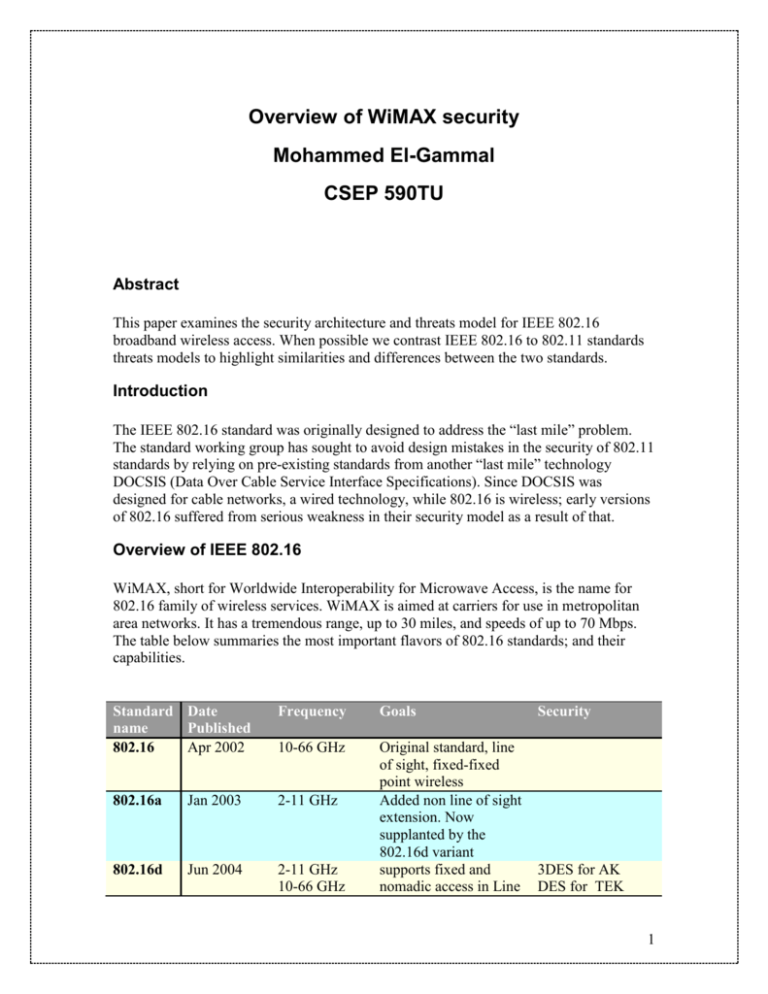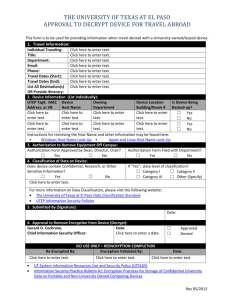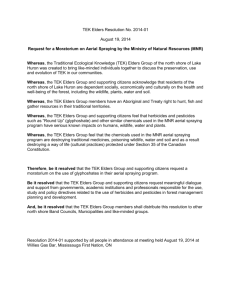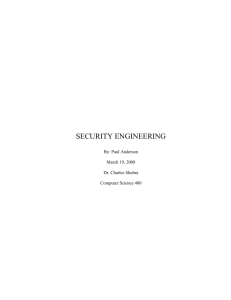Overview of WiMAX security
advertisement

Overview of WiMAX security
Mohammed El-Gammal
CSEP 590TU
Abstract
This paper examines the security architecture and threats model for IEEE 802.16
broadband wireless access. When possible we contrast IEEE 802.16 to 802.11 standards
threats models to highlight similarities and differences between the two standards.
Introduction
The IEEE 802.16 standard was originally designed to address the “last mile” problem.
The standard working group has sought to avoid design mistakes in the security of 802.11
standards by relying on pre-existing standards from another “last mile” technology
DOCSIS (Data Over Cable Service Interface Specifications). Since DOCSIS was
designed for cable networks, a wired technology, while 802.16 is wireless; early versions
of 802.16 suffered from serious weakness in their security model as a result of that.
Overview of IEEE 802.16
WiMAX, short for Worldwide Interoperability for Microwave Access, is the name for
802.16 family of wireless services. WiMAX is aimed at carriers for use in metropolitan
area networks. It has a tremendous range, up to 30 miles, and speeds of up to 70 Mbps.
The table below summaries the most important flavors of 802.16 standards; and their
capabilities.
Standard Date
name
Published
Apr 2002
802.16
Frequency
Goals
Security
10-66 GHz
Original standard, line
of sight, fixed-fixed
point wireless
Added non line of sight
extension. Now
supplanted by the
802.16d variant
supports fixed and
nomadic access in Line
3DES for AK
DES for TEK
802.16a
Jan 2003
2-11 GHz
802.16d
Jun 2004
2-11 GHz
10-66 GHz
1
Standard Date
name
Published
802.16e
Feb 2006
Frequency
2-6 GHz
Goals
Security
of Sight and Non Line
of Sight environments
Optimized for dynamic
mobile radio channels,
provides support for
handoffs and roaming
X.509
AES-CCM
As the table above shows, the standards went through many phases of evolution, it started
as a line of sight, last mile fixed-to-fixed point, it evolved to near line of sight fixed-tofixed point, then to near line of sight roaming friendly standard. This evolution becomes
important as we consider the security of this standard.
IEEE 802.16 security alphabet soup
BS
SS
SA
SAID
PKM
KEK
TEK
AK
Base station
Subscriber station
Security association/context
SA identification
Privacy and key management protocol
Key encryption key
Traffic encryption key
Authorization Key
IEEE 802.16 security architecture
The security architecture of IEEE 802.16 is comprised of five components:
1. Security associations – a context to maintain the security state relevant to a
connection between a base station (BS) and a subscriber station (SS).
2. Certificate profile – X.509 to identify communication parties to each other
3. PKM authorization – authorization protocol to distribute an authorization token to
an authorized SS.
4. Privacy and key management – a protocol to rekey the SA
5. Encryption – payload field encryption using DES-CBC in 802.16d, DES-CBC and
AES-CCM in 802.16e
We will look into the architecture of each of these components; discuss how they are
used and how they interact with each other.
Security associations:
2
The role of security associations (SA) is to maintain the security state/context relevant to
a connection; it operates at MAC layer – layer 2 of the network stack. There are two SA
types in 802.16, data SA and authorization SA. The authorization SA consists of:
An X.509 certificate identifying the SS
A 160-bit authorization key (AK) – the design assumes that both SS and BS
maintain AK a secret
An AK lifetime – from one to 70 days
A key encryption key, KEK1, used in distributing the TEKs
A downlink and uplink HMAC key providing data authenticity of key distribution
from BS to SS, and from SS to BS
A list of authorized data SAs
The standard explicitly defines the data SA. The data SA has the following fields:
SA identifier SAID,
The crypto algorithms supported by the BS to protect data exchange over the
connection. The standard requires DES-CBC mode, however the design is
extensible. Their have been several proposal to incorporates other algorithms e.g.
AES will be supported in 802.16e version of the standard,
Two traffic encryption keys (TEK),
A TEK lifetime – default is half day, with minimum of 30 mins, and max of seven
days,
A initialization vector for each TEK
To support multicast, the standard lets many connections IDs share an SA. Therefore a
fixed SS typically has two or three SAs – three in the case of multicast.
Certificate profile:
The standard uses X.509v3 certificates to identify communicating parties. The standard
defines two certificate types: manufacture certificates and SS certificates. The
manufacture certificate identifies the manufacture of 802.16 device (network card, base
station,…etc.). The certificate has the following format:
1
X.509v3
Serial number
Issuer name
Issuer’s signature algorithm– RSA with SHA1
Validity period
Holder’s identity – in the case of SS its MAC address
Holder’s public key – restricted to RSA
Subject signature algorithm – identical to the issuer algorithm
The KEK is calculated using first 128-bits of SHA1((AK | 044) + 5364)
3
Issuers signature
An SS certificate identifies the subscriber station and includes its MAC address in the
subject field. Manufacturers typically create and sign SS certificates. The design assumes
the SS maintains the private key corresponding to its public key in sealed tamper resistant
storages.
The privacy and key management (PKM) authorization:
The PKM authorization protocol is used to distribute an authorization keys to an
authorized SS. This step involves three messages exchanges.
Message 1: PKM-REQ: Auth info
SS {Manufacturer-Cert} BS
- BS uses it to decide if SS is a trusted device
Message 2: PKM-REQ: Auth req
SS {(SS-cert, Capabilities, SAID} BS
Message 3: PKM-RSP: Auth reply
BS {{AK}RSA public key of SS, key-lifetime, key-seq number, SAID list, SA-Type} SS
The SS uses its RSA private key to retrieve the AK. Correct use of the AK demonstrates
authorization to access the network.
The privacy and key management (PKM) protocol:
Once authorized to the network, the SS can now establish a data SA between it and the
BS, for that it again uses the PKM protocol. The phase can have two or three message
exchanges.
Message 1: PKM-REQ: key request
BS {AK Seq Number, SAID, HMAC(AKdownlink, Key seq number | SAID)} SS
BS never uses message 1 unless it wants to rekey a data SA or create a new SA. The
HMAC value ties the new SAID to AK used in the exchange.
Message 2: PKM-REQ: key request
SS {AK Seq Number, SAID, HMAC(AKuplink, Key seq number | SAID)} BS
SS uses message 2 to request SA parameters. The SAID has to be one from the SAID list
in the authorization protocol or message 1.
Message 3: PKM-RSP: key reply
BS {AK seq number, SAID, TEK parameters (older), TEK, key-liftime, AK seq number,
CBC-IV, TEK-parameters(newer), TEK, Key-lifetime, AK sq number, CBC-IV, HMACdigest}KEK SS
4
The old TEK value reiterates the active SA parameter, while the new TEK describes the
new TEK to use when the old one expires. It is noteworthy that the PKM protocol is one
side authentication from the BS side, there is no comparable authentication from the SS
side.
Encryption
By default the 802.16d standard supports DES-CBC encryption operating over the
payload field of the MAC protocol data unit. Neither the MAC header nor the packet
CRC is encrypted. It is noteworthy that the 802.16d version of the standard doesn’t
provide any means for data authenticity.
The PKM protocol in action
The registration of a subscriber station on the network involves the following steps:
5
SS
BS
PKM-REQ: Auth info
Manufacturer-Cert
PKMAuthorization
PKM-REQ: Auth req
SS-cert, Capabilities, SAID
Verify
- manufacture cert
- SS cert
Generate
-AK
PKM-RSP: Auth reply
{AK}RSA public key of SS, key-lifetime,
key-seq number, SAID list, SA-Type
Verify
- SAID is in SAID list
Generate
-TEK
PKM-REQ: key request
AK Seq Number, SAID,
HMAC(AKuplink, Key seq number | SAID)
PKM-RSP: key reply
{AK seq number, SAID, TEK, TEK, key-liftime, HMAC-digest}}kek
TEK Clear Data
Block0
DES
+
IV
Clear Data
TEK Block1
DES
Data
GMH, {data}TEK CRC
+
TEK Clear Data
Block2
DES
+
Cipher Block Chaining of
DES using the TEK
Data
GMH, {data}TEK CRC
SA
PKM authorization in 802.16d
6
Threat Analysis for 802.16
In section we examine threat model for 802.16 standards; we focus on the 802.16d
version of the standard, and when possible we will contrast them to threats to 802.11 to
highlights lessons learned.
Physical layer attacks:
As noted above the security of 802.16 is implemented at the bottom of layer 2 of the
network stack, this leaves the physical layer of the network unprotected. As most radio
networks using narrow bandwidth, 802.16 is susceptible to jamming and DoS attacks. An
attacker can use a probably configured radio station to mount either continuous or
intermittent jamming attacks on the radio spectrum. This type of attack is also possible in
802.11 standards, although the vulnerability and potential damage is much higher in
WMAN. There are several options to dealing with jamming attacks, increasing the power
of signals by using high gain transmission antennas or increasing the bandwidth by using
spreading techniques – e.g. frequency hopping. However, it seems that the designers of
stranded have opted, at least for now, to leave dealing with these kind of attacks to law
enforcement agencies.
MAC Layer attacks:
Although physical layer attacks are possible they might prove to be the least important
type of attacks on 802.16 networks. MAC layer attacks on the other hand can be more
serious, and can cause more damage to users and service providers. We consider here
some of these attacks:
Replay attacks – as noted above 802.16 authentication works in one direction, base
station authenticating subscriber stations, this design leaves clients vulnerable to replay
attacks. Since 802.16 supports near line of sight operation, a well positioned attacker can
act as a man in middle between a base station and a number of subscribers, by
configuring a rouge base station (BS) to imitate a legitimate BS. This type of attack is a
well known threat in 802.11 networks1, although it will be harder to mount on 802.16
because the time division multiple access model, but it not impossible. As part of the
development of 802.16e there were several proposals to require mutual authentication
which would make this type of attacks more difficult to mount2.
Authentication Key (AK) weaknesses - The authentication key has several weaknesses;
for start the standard doesn’t impose requirements on the randomness of generating the
key3, it assumes uniform distribution over the 160-bits for the key, this assumption leaves
the door open for different implementation from different manufactures which could lead
to less than random keys. Since the key is entirely generated by the BS, with no input
from the SS, this puts the burden on the BS random generator to be perfect; if the random
number generator has any kind of bias the result will be reducing the key space for the
AKs, which in turn could compromise subsequent TEKs for all SS connecting to the
same BS. Finally, the protocol assumes a one-to-one relation between a subscriber station
MAC address and the public/private key pair certified to use by that SS. This can cause
problems for public access machines; if an attacker can obtain the private key for a public
7
access machine they can easily retrieve the AK for subsequent accesses from the same
machine, allowing them to snoop all the traffic from that machine.
Traffic Encryption Keys (TEK) weaknesses - As noted above the traffic encryption keys
(TEKs) are rekeyable. The space for rekeying is 2-bits wide, causing the TEKs to wrap
every forth rekeying. This limited keying space and the use of sequence number instead
of RNG make the protocol more vulnerable to replay attacks. The TEK also suffers from
the lack of clear definition of ‘randomness’ that the AK suffers from.
Data packets encryption weaknesses - The TEK protected data packets suffer from a
couple of weaknesses. First, TEK are 56-bit DES keys, making the data packets less
secure than AES protected packets. The MAC header of the packets is not ciphered to
allow for easier routing, however, the MAC header should have been included in
integrity protected parts of the data packet to guarantee data authenticity; instead, the
2001 version of the standard states that “data authentication is not currently defined4”.
Finally, TEK encryption protects against read-only attacks, which leaves the data packets
unprotected against replay attacks, even when the attacker doesn’t have the key. It is
interesting to note that 802.11b WEP suffers from some if not all of these weaknesses.
X.509 certification is limiting – The standard defines a single manufacturer credential
based on X.509, this will proved to limiting in practical use. The standard is also silent on
how to handle revocation of certificate in case the private key is compromised. It is
obvious that the certification model assumes cable modem and DSL models.
Comparison to 802.11
In this section we will try to summaries the security features of different important
flavors of IEEE 802.11 and 802.16
Security
802.11b
feature
Authentication WEP
Data
Encryption
Data integrity
Physical layer
defense
None
WEP
No
No
802.11i
802.16d
802.16e
EAP
X.509 one way
WPA
AES
YES
No
DES-CBC
PKMv2
EAP (optional)
DEC-CBC
AES-CCM
Yes5
No
No
No
Conclusion
The first incarnations of WiMAX, exemplified in IEEE 802.16d, proved to be more
secure than the early versions of 802.11. They included an authentication protocol, PKM,
which is separated from the data encryption/decryption protocol – usinf a common
protocol/key was a serious flaw in 802.11b, and they included a more secure data
8
encryption algorithm. Unfortunately, the encryption algorithm t used, i.e. DES, is weaker
than the state of the art, and data integrity was not given enough attention.
The most recent incantation of WiMAX, IEEE 802.16e fixed many of the problems the
security community highlighted in 802.16d, by adding data integrity mechanisms, mutual
authentication, and AES-CCM for data packets encryptions. However, given how new
the standard is -- it was published Feb 2006 -- it remains to be seen how secure it will
prove to be in practice.
References
1
Ernest and Young, the necessity of rouge wireless device detection, paper 2004
IEEE Std 802.16e-2005 published Feb 28, 2006
3
Johnson and Walker ‘Overview of 802.16 security’ IEEE security and privacy 2004
4
IEEE 802.16-2001, published Apr 4, 2002
5
Michel Barbeau, WiMax/802.16 Threat Analysis
2
9








